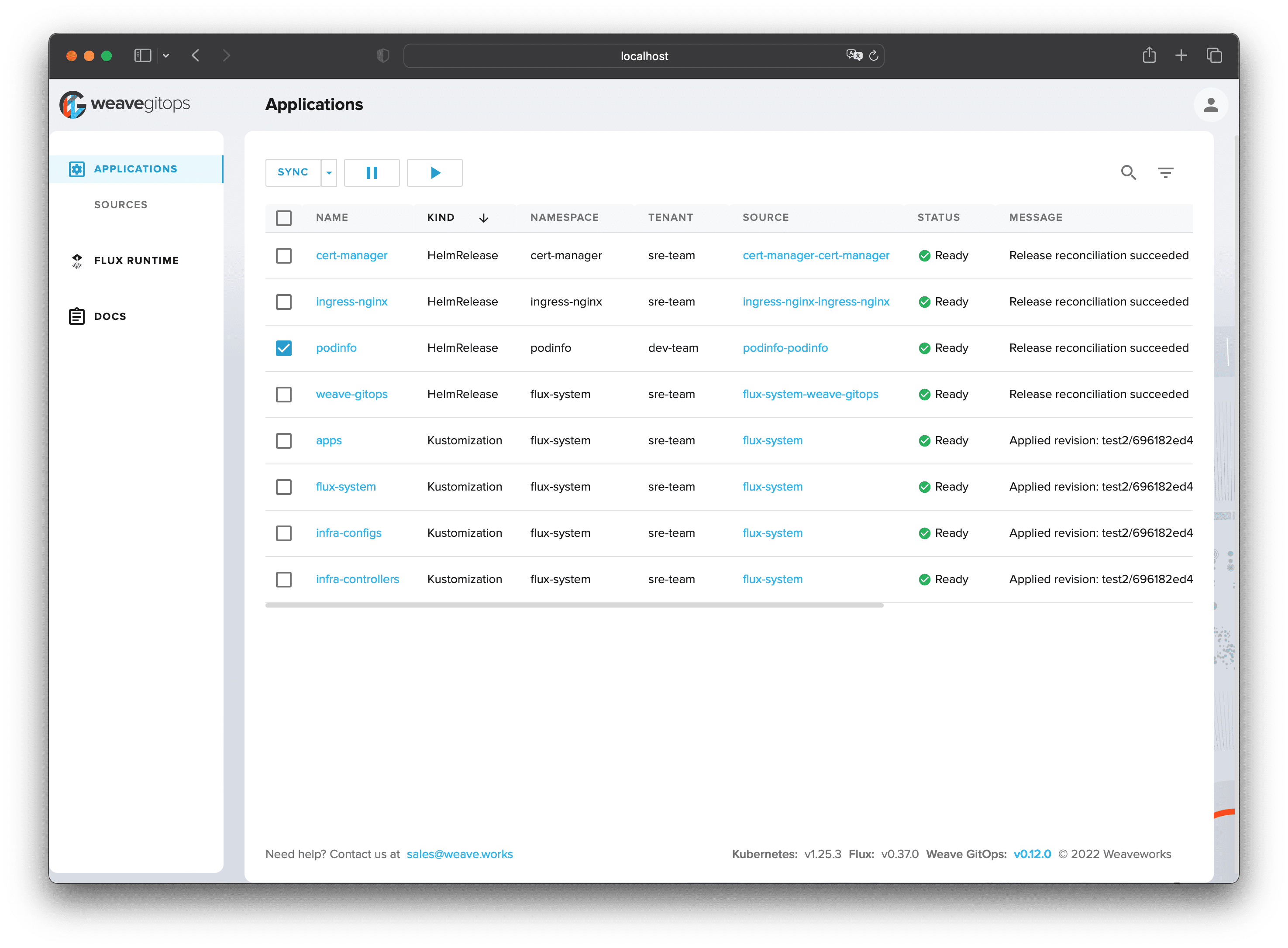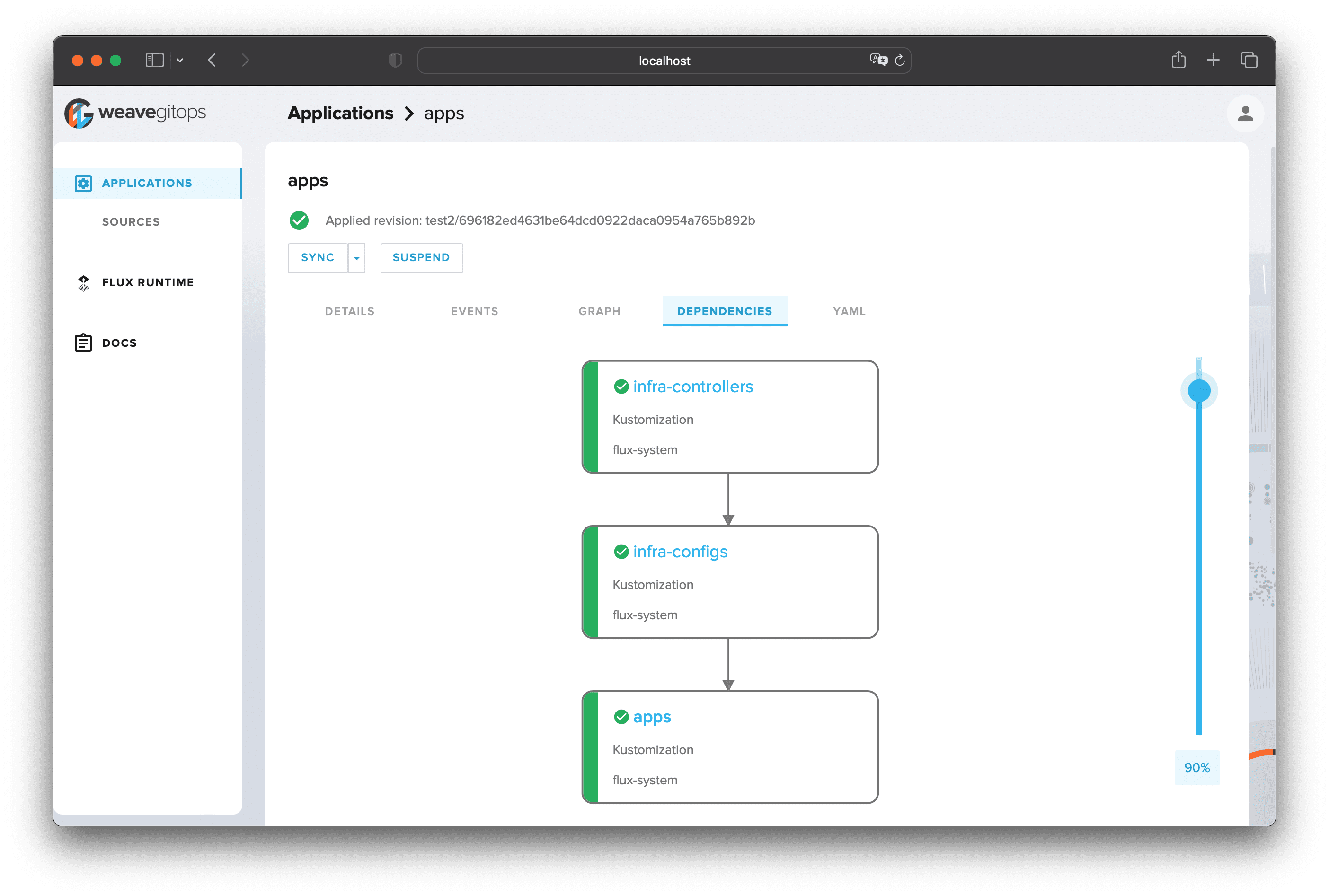For this example we assume a scenario with two clusters: staging and production. The end goal is to leverage Flux and Kustomize to manage both clusters while minimizing duplicated declarations.
We will configure Flux to install, test and upgrade a demo app using
HelmRepository and HelmRelease custom resources.
Flux will monitor the Helm repository, and it will automatically
upgrade the Helm releases to their latest chart version based on semver ranges.
On each cluster, we'll install Weave GitOps (an OSS UI for Flux) to visualise and monitor the workloads managed by Flux.
You will need a Kubernetes cluster version 1.21 or newer. For a quick local test, you can use Kubernetes kind. Any other Kubernetes setup will work as well though.
In order to follow the guide you'll need a GitHub account and a
personal access token
that can create repositories (check all permissions under repo).
Install the Flux CLI on MacOS or Linux using Homebrew:
brew install fluxcd/tap/fluxOr install the CLI by downloading precompiled binaries using a Bash script:
curl -s https://fluxcd.io/install.sh | sudo bashThe Git repository contains the following top directories:
- apps dir contains Helm releases with a custom configuration per cluster
- infrastructure dir contains common infra tools such as ingress-nginx and cert-manager
- clusters dir contains the Flux configuration per cluster
├── apps
│ ├── base
│ ├── production
│ └── staging
├── infrastructure
│ ├── configs
│ └── controllers
└── clusters
├── production
└── staging
The apps configuration is structured into:
- apps/base/ dir contains namespaces and Helm release definitions
- apps/production/ dir contains the production Helm release values
- apps/staging/ dir contains the staging values
./apps/
├── base
│ └── podinfo
│ ├── kustomization.yaml
│ ├── namespace.yaml
│ ├── release.yaml
│ └── repository.yaml
├── production
│ ├── kustomization.yaml
│ └── podinfo-patch.yaml
└── staging
├── kustomization.yaml
└── podinfo-patch.yaml
In apps/base/podinfo/ dir we have a Flux HelmRelease with common values for both clusters:
apiVersion: helm.toolkit.fluxcd.io/v2beta1
kind: HelmRelease
metadata:
name: podinfo
namespace: podinfo
spec:
releaseName: podinfo
chart:
spec:
chart: podinfo
sourceRef:
kind: HelmRepository
name: podinfo
namespace: flux-system
interval: 50m
values:
ingress:
enabled: true
className: nginxIn apps/staging/ dir we have a Kustomize patch with the staging specific values:
apiVersion: helm.toolkit.fluxcd.io/v2beta1
kind: HelmRelease
metadata:
name: podinfo
spec:
chart:
spec:
version: ">=1.0.0-alpha"
test:
enable: true
values:
ingress:
hosts:
- host: podinfo.stagingNote that with version: ">=1.0.0-alpha" we configure Flux to automatically upgrade
the HelmRelease to the latest chart version including alpha, beta and pre-releases.
In apps/production/ dir we have a Kustomize patch with the production specific values:
apiVersion: helm.toolkit.fluxcd.io/v2beta1
kind: HelmRelease
metadata:
name: podinfo
namespace: podinfo
spec:
chart:
spec:
version: ">=1.0.0"
values:
ingress:
hosts:
- host: podinfo.productionNote that with version: ">=1.0.0" we configure Flux to automatically upgrade
the HelmRelease to the latest stable chart version (alpha, beta and pre-releases will be ignored).
The infrastructure is structured into:
- infrastructure/controllers/ dir contains namespaces and Helm release definitions for Kubernetes controllers
- infrastructure/configs/ dir contains Kubernetes custom resources such as cert issuers and networks policies
./infrastructure/
├── configs
│ ├── cluster-issuers.yaml
│ ├── network-policies.yaml
│ └── kustomization.yaml
└── controllers
├── cert-manager.yaml
├── ingress-nginx.yaml
├── weave-gitops.yaml
└── kustomization.yaml
In infrastructure/controllers/ dir we have the Flux HelmRepository and HelmRelease definitions such as:
apiVersion: helm.toolkit.fluxcd.io/v2beta1
kind: HelmRelease
metadata:
name: cert-manager
namespace: cert-manager
spec:
interval: 30m
chart:
spec:
chart: cert-manager
version: "1.x"
sourceRef:
kind: HelmRepository
name: cert-manager
namespace: cert-manager
interval: 12h
values:
installCRDs: trueNote that with interval: 12h we configure Flux to pull the Helm repository index every twelfth hours to check for updates.
If the new chart version that matches the 1.x semver range is found, Flux will upgrade the release.
In infrastructure/configs/ dir we have Kubernetes custom resources, such as the Let's Encrypt issuer:
apiVersion: cert-manager.io/v1
kind: ClusterIssuer
metadata:
name: letsencrypt
spec:
acme:
# Replace the email address with your own contact email
email: fluxcdbot@users.noreply.github.com
server: https://acme-staging-v02.api.letsencrypt.org/directory
privateKeySecretRef:
name: letsencrypt-nginx
solvers:
- http01:
ingress:
class: nginxIn clusters/production/infrastructure.yaml we replace the Let's Encrypt server value to point to the production API:
apiVersion: kustomize.toolkit.fluxcd.io/v1beta2
kind: Kustomization
metadata:
name: infra-configs
namespace: flux-system
spec:
# ...omitted for brevity
dependsOn:
- name: infra-controllers
patches:
- patch: |
- op: replace
path: /spec/acme/server
value: https://acme-v02.api.letsencrypt.org/directory
target:
kind: ClusterIssuer
name: letsencryptNote that with dependsOn we tell Flux to first install or upgrade the controllers and only then the configs.
This ensures that the Kubernetes CRDs are registered on the cluster, before Flux applies any custom resources.
The clusters dir contains the Flux configuration:
./clusters/
├── production
│ ├── apps.yaml
│ └── infrastructure.yaml
└── staging
├── apps.yaml
└── infrastructure.yaml
In clusters/staging/ dir we have the Flux Kustomization definitions, for example:
apiVersion: kustomize.toolkit.fluxcd.io/v1beta2
kind: Kustomization
metadata:
name: apps
namespace: flux-system
spec:
interval: 10m0s
dependsOn:
- name: infra-configs
sourceRef:
kind: GitRepository
name: flux-system
path: ./apps/staging
prune: true
wait: trueNote that with path: ./apps/staging we configure Flux to sync the staging Kustomize overlay and
with dependsOn we tell Flux to create the infrastructure items before deploying the apps.
Fork this repository on your personal GitHub account and export your GitHub access token, username and repo name:
export GITHUB_TOKEN=<your-token>
export GITHUB_USER=<your-username>
export GITHUB_REPO=<repository-name>Verify that your staging cluster satisfies the prerequisites with:
flux check --preSet the kubectl context to your staging cluster and bootstrap Flux:
flux bootstrap github \
--context=staging \
--owner=${GITHUB_USER} \
--repository=${GITHUB_REPO} \
--branch=main \
--personal \
--path=clusters/stagingThe bootstrap command commits the manifests for the Flux components in clusters/staging/flux-system dir
and creates a deploy key with read-only access on GitHub, so it can pull changes inside the cluster.
Watch for the Helm releases being installed on staging:
$ watch flux get helmreleases --all-namespaces
NAMESPACE NAME REVISION SUSPENDED READY MESSAGE
cert-manager cert-manager v1.10.1 False True Release reconciliation succeeded
flux-system weave-gitops 4.0.9 False True Release reconciliation succeeded
ingress-nginx ingress-nginx 4.4.0 False True Release reconciliation succeeded
podinfo podinfo 6.2.3 False True Release reconciliation succeededVerify that the demo app can be accessed via ingress:
$ kubectl -n nginx port-forward svc/nginx-ingress-controller 8080:80 &
$ curl -H "Host: podinfo.staging" http://localhost:8080
{
"hostname": "podinfo-59489db7b5-lmwpn",
"version": "6.2.3"
}Bootstrap Flux on production by setting the context and path to your production cluster:
flux bootstrap github \
--context=production \
--owner=${GITHUB_USER} \
--repository=${GITHUB_REPO} \
--branch=main \
--personal \
--path=clusters/productionWatch the production reconciliation:
$ flux get kustomizations --watch
NAME REVISION SUSPENDED READY MESSAGE
apps main/696182e False True Applied revision: main/696182e
flux-system main/696182e False True Applied revision: main/696182e
infra-configs main/696182e False True Applied revision: main/696182e
infra-controllers main/696182e False True Applied revision: main/696182e To access the Flux UI on a cluster, first start port forwarding with:
kubectl -n flux-system port-forward svc/weave-gitops 9001:9001Navigate to http://localhost:9001 and login using the username admin and the password flux.
Weave GitOps provides insights into your application deployments, and makes continuous delivery with Flux easier to adopt and scale across your teams. The GUI provides a guided experience to build understanding and simplify getting started for new users; they can easily discover the relationship between Flux objects and navigate to deeper levels of information as required.
You can change the admin password bcrypt hash in infrastructure/controllers/weave-gitops.yaml:
apiVersion: helm.toolkit.fluxcd.io/v2beta1
kind: HelmRelease
metadata:
name: weave-gitops
namespace: flux-system
spec:
# ...omitted for brevity
values:
adminUser:
create: true
username: admin
# bcrypt hash for password "flux"
passwordHash: "$2a$10$P/tHQ1DNFXdvX0zRGA8LPeSOyb0JXq9rP3fZ4W8HGTpLV7qHDlWhe"To generate a bcrypt hash please see Weave GitOps documentation.
Note that on production systems it is recommended to expose Weave GitOps over TLS with an ingress controller and to enable OIDC authentication for your organisation members. To configure OIDC with Dex and GitHub please see this guide.
If you want to add a cluster to your fleet, first clone your repo locally:
git clone https://github.com/${GITHUB_USER}/${GITHUB_REPO}.git
cd ${GITHUB_REPO}Create a dir inside clusters with your cluster name:
mkdir -p clusters/devCopy the sync manifests from staging:
cp clusters/staging/infrastructure.yaml clusters/dev
cp clusters/staging/apps.yaml clusters/devYou could create a dev overlay inside apps, make sure
to change the spec.path inside clusters/dev/apps.yaml to path: ./apps/dev.
Push the changes to the main branch:
git add -A && git commit -m "add dev cluster" && git pushSet the kubectl context and path to your dev cluster and bootstrap Flux:
flux bootstrap github \
--context=dev \
--owner=${GITHUB_USER} \
--repository=${GITHUB_REPO} \
--branch=main \
--personal \
--path=clusters/devIf you want to spin up an identical environment, you can bootstrap a cluster
e.g. production-clone and reuse the production definitions.
Bootstrap the production-clone cluster:
flux bootstrap github \
--context=production-clone \
--owner=${GITHUB_USER} \
--repository=${GITHUB_REPO} \
--branch=main \
--personal \
--path=clusters/production-clonePull the changes locally:
git pull origin mainCreate a kustomization.yaml inside the clusters/production-clone dir:
apiVersion: kustomize.config.k8s.io/v1beta1
kind: Kustomization
resources:
- flux-system
- ../production/infrastructure.yaml
- ../production/apps.yamlNote that besides the flux-system kustomize overlay, we also include
the infrastructure and apps manifests from the production dir.
Push the changes to the main branch:
git add -A && git commit -m "add production clone" && git pushTell Flux to deploy the production workloads on the production-clone cluster:
flux reconcile kustomization flux-system \
--context=production-clone \
--with-source Any change to the Kubernetes manifests or to the repository structure should be validated in CI before a pull requests is merged into the main branch and synced on the cluster.
This repository contains the following GitHub CI workflows:
- the test workflow validates the Kubernetes manifests and Kustomize overlays with kubeconform
- the e2e workflow starts a Kubernetes cluster in CI and tests the staging setup by running Flux in Kubernetes Kind


